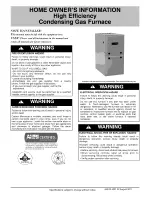
24
Use a separate fused branch electrical circuit containing prop
-
erly sized wire, and fuse or circuit breaker. The fuse or circuit
breaker must be sized in accordance with the maximum
overcurrent protection specified on the unit rating plate. An
electrical disconnect must be provided at the furnace location.
Connect hot, neutral, and ground wires as shown in the wir
-
ing diagram located on the unit’s blower door. Metal conduit
is not considered a substitute for an actual ground wire to
the unit. For direct vent applications, the cabinet opening to
the junction box must be sealed air tight using either an UL
approved bushing such as Heyco Liquid Tight or by applying
non-reactive UL approved sealant to bushing.
Line polarity must be observed when making field connec
-
tions. Line voltage connections can be made through either
the right or left side panel. The furnace is shipped configured
for a left side electrical connection with the junction box
located inside the burner compartment. To make electri
-
cal connections through the opposite side of the furnace,
the junction box must be relocated to the other side of the
burner compartment prior to making electrical connections.
To relocate the junction box, follow the steps shown below.
NOTE:
Wire routing must not to interfere with circulator
blower operation, filter removal, or routine maintenance.
Junction Box Relocation
E
DGES
OF
SHEET
METAL
HOLES
MAY
BE
SHARP
. U
SE
GLOVES
AS
A
PRECAUTION
WHEN
REMOVING
HOLE
PLUGS
.
WARNING
T
O
PREVENT
PERSONAL
INJURY
OR
DEATH
DUE
TO
ELECTRIC
SHOCK
,
DISCONNECT
ELECTRICAL
POWER
BEFORE
INSTALLING
OR
SERVICING
THIS
UNIT
.
WARNING
HIGH VOLTAGE !
T
O
AVOID
THE
RISK
OF
INJURY
,
ELECTRICAL
SHOCK
OR
DEATH
,
THE
FURNACE
MUST
BE
ELECTRICALLY
GROUNDED
IN
ACCORDANCE
WITH
LOCAL
CODES
OR
IN
THEIR
ABSENCE
,
WITH
THE
LATEST
EDITION
OF
THE
N
ATIONAL
E
LECTRIC
C
ODE
.
WARNING
Line voltage connections can be made through either the right
or left side panel. The furnace is shipped configured for a left
side electrical connection. To make electrical connections
through the opposite side of the furnace, the junction box
must be relocated to the left side prior to making electrical
connections. To relocate the junction box, perform the fol
-
lowing steps.
1. Remove the burner compartment door.
2. Remove and save the two screws securing the junction
box to the side panel.
3. Relocate junction box and associated plugs and
grommets to opposite side panel. Secure with screws
removed in step 2.
To ensure proper unit grounding, the ground wire should run
from the furnace ground screw located inside the furnace
junction box all the way back to the electrical panel.
NOTE:
Do not use gas piping as an electrical ground. To confirm
proper unit grounding, turn off the electrical power and per
-
form the following check.
1. Measure resistance between the neutral (white)
connection and one of the burners.
2. Resistance should measure 10 ohms or less.
This furnace is equipped with a blower door interlock switch
which interrupts unit voltage when the blower door is opened
for servicing. Do not defeat this switch.
24 Volt Thermostat Wiring
W
IRE
ROUTING
MUST
NOT
INTERFERE
WITH
CIRCULATOR
BLOWER
OPERATION
,
FILTER
REMOVAL
OR
ROUTINE
MAINTENANCE
.
IMPORTANT NOTE
Low voltage connections can be made through either the
right or left side panel. Thermostat wiring entrance holes
are located in the blower compartment. The following figure
shows connections for a “heat/cool system”.
This furnace is equipped with a 40 VA transformer to facilitate
use with most cooling equipment. Consult the wiring diagram,
located on the blower compartment door, for further details
of 115 Volt and 24 Volt wiring.
Thermostat - Single -Stage Heating with Single-Stage
Cooling
NOTE:
To apply a single-stage Heating Thermostat, the thermostat
selector switch on the Integrated Control Module
must
be set on
single-stage.
Figure 34
Y
C
Y
C
G
R
W/W1
Y2
Y/Y1
C
G
R
W/W1
W2
ROOM THERMOSTAT
INTEGRATED FURNACE
CONTROL MODULE
REMOTE COOLING UNIT
(SINGLE STAGE)
W2
Thermostat - Two-Stage Hea
ti
ng with Single-Stage Cooling
Thermostat - Two-Stage Heating with Single-Stage Cooling
Figure 35














































